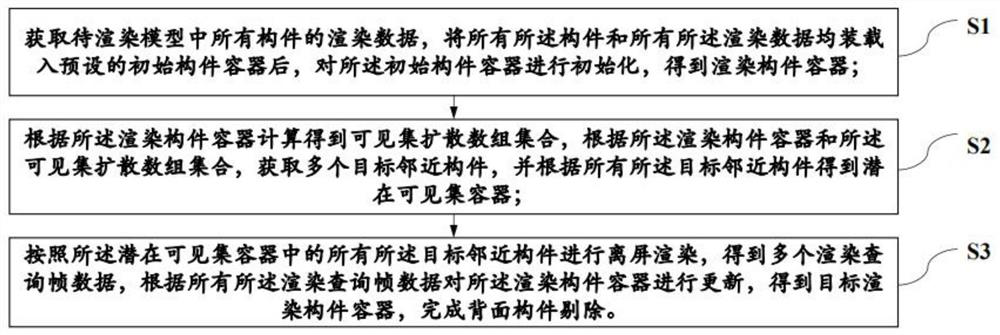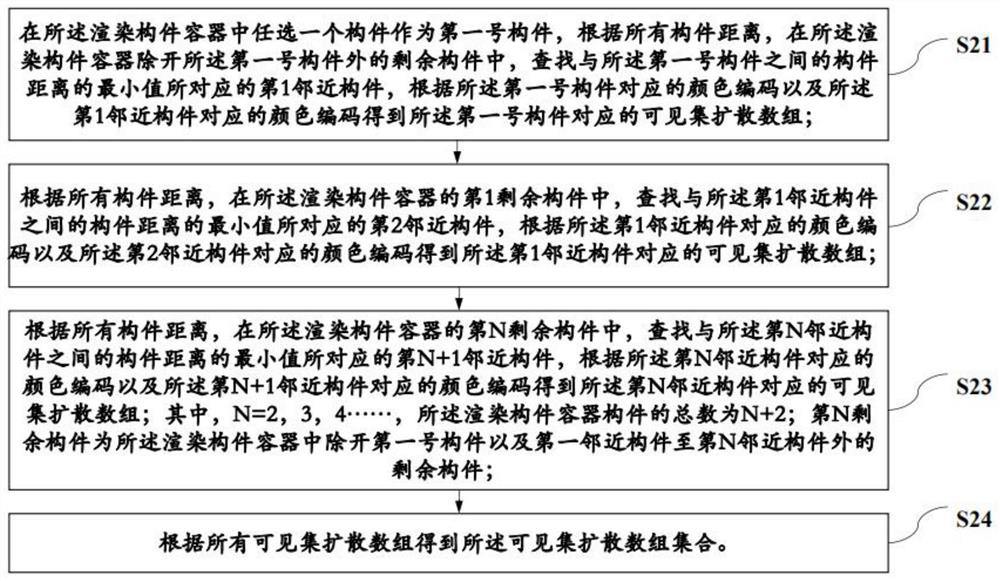Back component removing method and system based on off-screen rendering and storage medium
An off-screen rendering and component technology, applied in image data processing, instrumentation, computing, etc., can solve problems such as large fluctuations in the ratio of invisible sets to total components, poor query effect of invisible components, unstable rendering frame rate, etc. , to achieve the effect of self-contained detail elimination, remarkable query effect, and graphics rendering performance
- Summary
- Abstract
- Description
- Claims
- Application Information
AI Technical Summary
Problems solved by technology
Method used
Image
Examples
Embodiment 1
[0028] Embodiment one, as figure 1 As shown, a back component culling method based on off-screen rendering includes the following steps:
[0029] S1: Obtain the rendering data of all the components in the model to be rendered, load all the components and all the rendering data into a preset initial component container, initialize the initial component container, and obtain the rendering component container;
[0030] S2: Calculate the visible set diffusion array set according to the rendering component container, obtain multiple target adjacent components according to the rendering component container and the visible set diffusion array set, and obtain a potential visible set according to all the target adjacent components container;
[0031] S3: Perform off-screen rendering according to all the target adjacent components in the potentially visible set container to obtain multiple rendering query frame data, and update the rendering component container according to all the ren...
Embodiment 2
[0067]Embodiment two, such as Figure 7 As shown, a system for removing rear components based on off-screen rendering is applied to the method for removing rear components based on off-screen rendering in Embodiment 1, including an initialization module, a calculation module, an off-screen rendering module, and an update module;
[0068] The initialization module is used to obtain the rendering data of all components in the model to be rendered, and after loading all the components and all the rendering data into a preset initial component container, initialize the initial component container, Get the rendering component container;
[0069] The calculation module is configured to calculate the visible set diffusion array set according to the rendering component container, acquire multiple target adjacent components according to the rendering component container and the visible set diffusion array set, and obtain a plurality of target adjacent components according to all the ta...
Embodiment 3
[0091] Embodiment 3. Based on Embodiment 1 and Embodiment 2, this embodiment also discloses a system for removing rear components based on off-screen rendering, including a processor, a memory, and a A computer program on the computer, the specific steps of S1 to S3 are implemented when the computer program runs.
[0092] Through the computer program stored in the memory and running on the processor, it is possible to eliminate the unrendered component geometry on the back of the model to be rendered or the component geometry that is not obvious from a distance, effectively improve the graphics rendering effect, and realize graphics rendering The performance optimization can query the potential visible set more accurately. When performing occlusion query and elimination of the back components of a large-scale model, it can distinguish whether the components are occluded with a higher recognition rate, and the query effect of invisible components is better. Notably, at the same...
PUM
 Login to View More
Login to View More Abstract
Description
Claims
Application Information
 Login to View More
Login to View More - R&D
- Intellectual Property
- Life Sciences
- Materials
- Tech Scout
- Unparalleled Data Quality
- Higher Quality Content
- 60% Fewer Hallucinations
Browse by: Latest US Patents, China's latest patents, Technical Efficacy Thesaurus, Application Domain, Technology Topic, Popular Technical Reports.
© 2025 PatSnap. All rights reserved.Legal|Privacy policy|Modern Slavery Act Transparency Statement|Sitemap|About US| Contact US: help@patsnap.com



